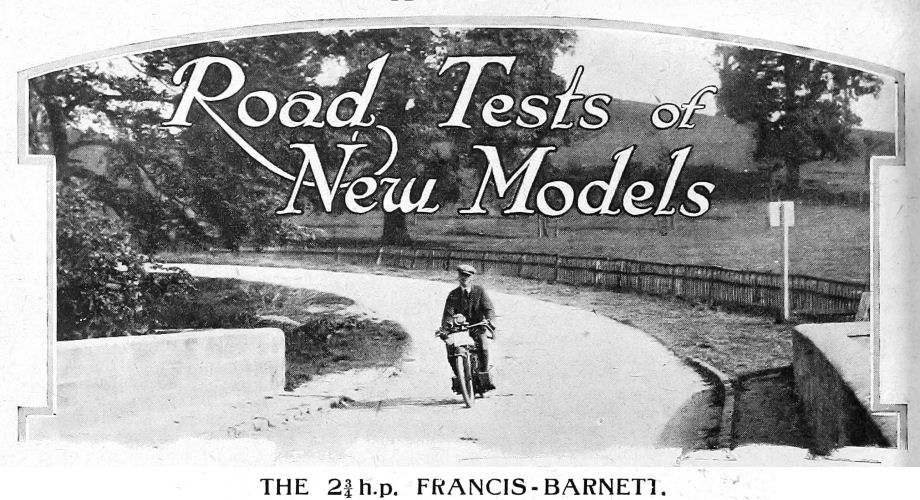



Road Tests of New Models. The Motor Cycle SEPTEMBER 22nd, 1921.
SPECIFICATION.
There are several commendable features about the 2¾ h.p. two-speed Francis-Barnett, among them being the saddle tank, a quickly adjustable rear brake, and a particularly neat chain cover.
The riding position of the Francis-Barnett is particularly comfortable, and one immediately feels at home on the mount.
ALTHOUGH the 3½ h.p. single is still perhaps the most popular type of solo mount in this country, it is being run a close second by the 2¾ h.p. machines.
During the last year or two this type has indeed proved itself to be both speedy and thoroughly reliable, as witness the excellent performance made by the tiny J. A. P. engine in the T.T. and recent 500 Miles Race ; these successes, coupled with the economical running of the type, will undoubtedly continue to gain for it the favour of many riders.
Glancing over the features of a dozen well-known lightweights, the similarity of the specification is striking, although to the average eye the machines look quite different. The 2¾ h.p. J. A. P. engine, Sturmey-Archer two-speed gear box, chain-cum-belt drive, wheel sizes, etc., convey the idea that such machines must be exactly similar in performance, and true, it is often difficult, when testing a variety of makes, to find any outstanding characteristic which would make one lean toward any particular one.
It was with this problem in mind that the writer recently took a standard 2¾ h.p. Francis-Barnett for a test run over the Cotswold Hills one very hot Sunday afternoon. This little mount, which is a typical example of the sturdy British lightweight, is familiar to most readers, so that adetailed specification is unnecessary - the chief characteristics being the saddle tank, short leg shields, and easily adjustable rear brake.
Leaving the garage at noon, the main road was followed to Broadway via Stratford, prior to trying the machine on the well-known trials hills of Saintbury, Willersey, and Rising Sun. The Francis-Barnett behaved very well, and it was not long before one realised that its real charm lay in its general handiness and controllability - the riding position, distribution of weight, and wheelbase length all combining to give the rider a sense of perfect security and comfort.
One becomes accustomed to any type of machine, but there are some mounts upon which one immediately feels " at home." The Francis- Barnett is one of them.
Turning off the main road at the familiar stone cross, we were soon humming up Saintbury, bottom gear being engaged about half-way up, the engine pulling well thereafter with plenty in hand. Willersey, the corresponding descent, provided an excellent opportunity for testing the brakes, and it was found possible to bring the machine to a dead stop on the steepest portion, the rear brake being exceedingly powerful.
On the way to Cheltenham a stop was made to run down the Rising Sun Hill (Gambles Lane), and attempt to reclimb it, back to the main road again, over the steep and loose gradient, a clean ascent being made without any fuss.
In spite of the fine weather very little traffic was encountered between Stratford and Cheltenham onboth outward and return journeys,and with a clear road it was found possible to ride mile after mile without touching the bars ; this is, of course, possible on other types, but how often does one find when testing the steering that the machine pulls to one side, and in some cases starts to wobble immediately the bars are released. This form of riding should not ordinarily be indulged in for obvious reasons, but it served to prove that the machine in question steers perfectly without the slightest wobble even when passing over a bad section of the road. The wide and smooth tank forms a very comfortable grip for the rider's knees.
It is after using such machines as this, after the heavier type, that one appreciates the vast strides made in lightweights in recent years.
Summing up, the Francis-Barnett is a well-made, speedy, and thoroughly reliable little solo mount, but undoubtedly that which appeals
to one most is its perfect controllability, a quality bringing it into the front rank of British lightweights.
Sources: The MotorCycle